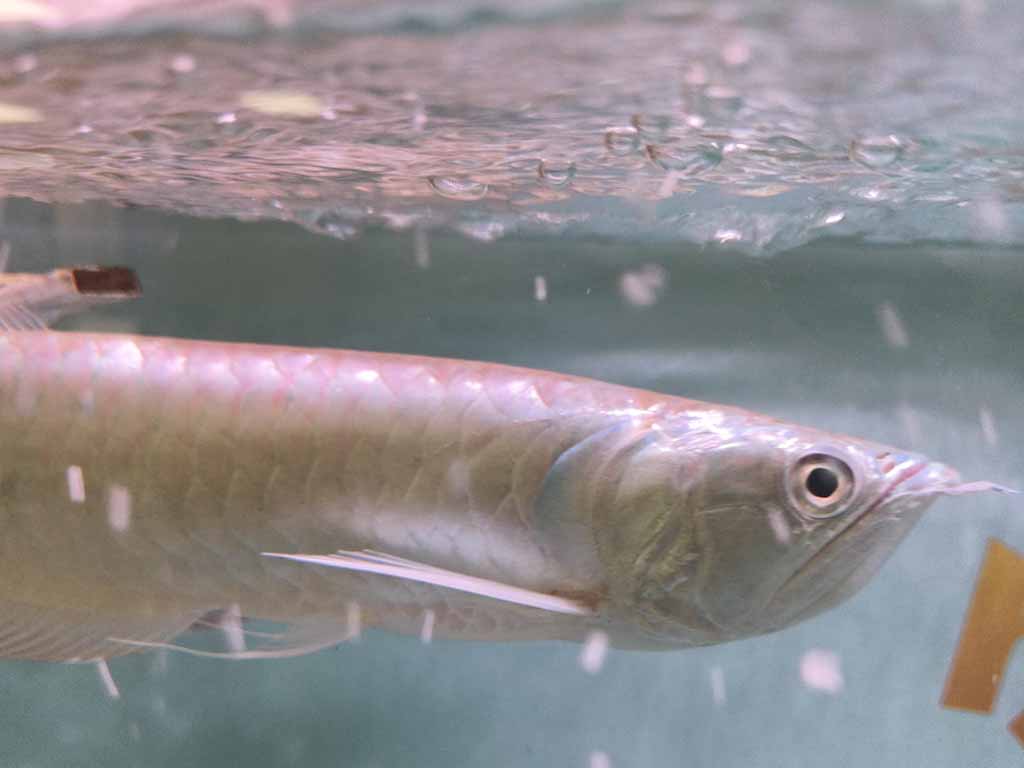If you are an Arowana enthusiast and have some worries about your fish bulging eyes, then this article is for you. It can be a stressful condition, but knowing it and knowing its causes and treatments, it can be managed right.
Content Table
In this article, we will explain what are arowana bulging eyes and why Arowana fish have bulging eyes, look at the bulging eyes arowana treatment you can use, and give you some basic care tips to follow to avoid similar occurrences in the future. Welcome to the world of Arowana eye health as we guide you to make sure your lovely fish stays in optimum form.

Silver pink fish
Arowana Bulging Eyes
Arowana bulging eyes, “drop eyes” or “protruding eyes” refers to the situation whereby the eyes of the Arowana fish extend downward or outside. This condition will make the fish have a different look from the normal smooth fins and body and is common to fish that are in captivity but very rare in those found in the wild.
What’s Wrong with the Bulging Eyes of Arowana
Bulging eyes in Arowana fish, often referred to as “Popeye”, can be caused by several factors:
- Injury: Accidents or collisions within the aquarium can cause trauma to the eye, leading to swelling and protrusion.
- Infection: Bacterial or fungal infections can cause inflammation and fluid buildup behind the eye.
- Poor Water Quality: High levels of ammonia, nitrite, or nitrate can irritate the eyes and lead to infection.
- Nutritional Deficiencies: A lack of essential nutrients in the diet can weaken the fish’s immune system and make it more susceptible to infections.
- Genetic Predisposition: In some cases, the fish’s genetics may make it more prone to eye problems.
- Drop Eye: This condition is more specific to arowanas and is caused by a combination of factors, including genetics, diet, and environmental conditions.

Arowana bulging eyes
Treatment of Arowana Protruding Eyes
Here are some potential treatments for bulging eyes in Arowana fish.
General Care
Water Quality: Water should be changed frequently, and the canister filter chosen should be of high quality. In addition, water parameters should be tested periodically. Any imbalance should be treated before it leads to further irritation or some sort of infection.
Diet: Feed a balanced diet of fresh/live and thawed foods and occasional canned or dry foods. Do not feed them too much because this results in unhygienic spoilage of the water and stresses the animals.
Aquarium Environment: Some general non-stress factors include maintaining stable water parameters, temperature fluctuations, and cover.
Quarantine: If the condition is thought to be infectious, the sick arowana should be separated from the others in the tank to avoid spreading the disease to other fish.
Medications
Antibiotics: In cases where the bulging eyes may be attributed to bacterial infections, the doctor may prescribe some antibiotics. Ask your veterinarian to recommend which antibiotic to use and in what strength.
Fungal Medications: If the eye protrusion or infection is due to bacteria or fungus, using medications specifically designed for fish (like Kanaplex or Maracyn) can help. Always follow dosage instructions carefully.
Eye Salves or Drops: Local application therapy may be administered by an ophthalmologist in certain circumstances to decrease inflammation and enhance the healing process. Speak with a veterinarian about which product to use and how to best apply it.

Bulging eyes arowana treatment
Home Remedies
Salt Baths: In general, magnesium sulfate can be helpful for fish, but when thinking about using a salt bath, it is crucial to check with a veterinarian. High salt content has an inflammatory effect and may have a favorable effect on arowana fish in short-term salt baths, but it is toxic to the fish.
| Epsom salt | Aquarium salt |
| As mentioned, adding Epsom salt can help reduce swelling associated with fluid buildup behind the eye. | It can help reduce stress and improve gill function but always monitor salinity levels. |
| Freshwater Rinses | Another management option is washing the affected eye with clear water to wash out the irritants and debris. However, be careful not to put any other material in the eye, which may worsen the irritation. |
Tips for Bulging Eyes Arowana Care
After Treatment
- Continue Monitoring: Even after treatment, continue to monitor Arowana’s eyes closely for any signs of recurrence or worsening.
- Maintain Water Quality: Ensure the aquarium’s water quality remains excellent to prevent future infections.
- Balanced Diet: Provide a nutritious diet to support the fish’s overall health and immune system.
- Stress Reduction: Minimize stress factors in the aquarium environment, such as sudden temperature changes or aggressive arowana tankmates.
Preventing Bulging Eyes
- Water Quality: Keep your water parameters where they should be at all times, such as ammonia, nitrite, nitrate, pH, and temperature. Water changes should be regular.
- Aquarium Setup: Offer plenty of room in a well-filtered and aeration aquarium. Don’t overcrowd and don’t make an environment too peaceful.
- Healthy Diet: Feed a diet containing good-quality feed. Don’t feed too much; excess food can cause water quality problems.
- Quarantine New Fish: New cleaner fish should be introduced into the main aquarium only after they have been put into quarantine to prevent the introduction of diseases or parasites.
- Regular Check-ups: Schedule regular check-ups with a veterinarian to check Arowana’s health and detect problems early.
- Avoid Harsh Chemicals: Do not use chemicals or medications of harshness in the tank, unless prescribed by a veterinarian.

Arowana eyes disease
Wrapping Up
Although sounding alarming, bulging eyes in arowana fish are generally easily treatable with enough care and attention. If you know what caused the problem, provide the right treatment, and keep the aquarium healthy, you can prevent further arowana problems and help it recover from what happened. Of course, always contact a veterinarian specializing in aquatic animals for a personalized diagnosis and treatment plan. Your arowana can live quite a long life, with the right care and monitoring.


Leave a comment